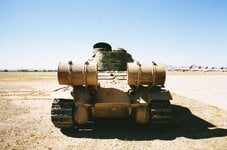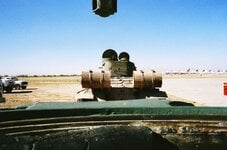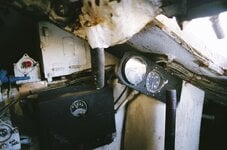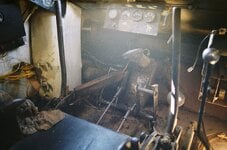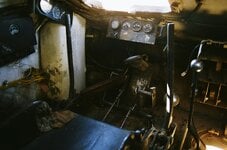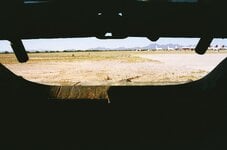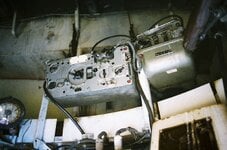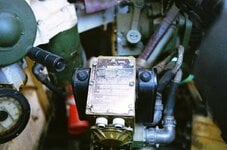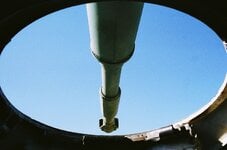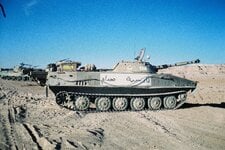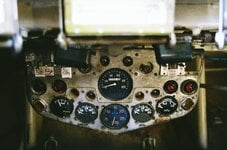Which is why, back in the '80s, we got the Sherman (M4A1E8), instead of the T34 (T34/85, Fresh out of Polish Army Reserve Stock. The Russian Stuff - Simple, in its way, and, as you note, you can fix it with a rock. But you need a lot of rocks.With the transmission in the front, the driver can be equipped with a hammer to give the transmission a whack if it's misbehaving!
Navigation
Install the app
How to install the app on iOS
Follow along with the video below to see how to install our site as a web app on your home screen.
Note: This feature may not be available in some browsers.
More options
You are using an out of date browser. It may not display this or other websites correctly.
You should upgrade or use an alternative browser.
You should upgrade or use an alternative browser.
Best tank engines of WWII
- Thread starter z42
- Start date
Ad: This forum contains affiliate links to products on Amazon and eBay. More information in Terms and rules
More options
Who Replied?Merkeva was born out of the experience of the 1973 Yom Kippur War against Egypt & Syria. Out of 2,500 Israeli Army dead, nearly 1,500 came from the Armoured Corps. That included many experienced reservists and severely weakened the Corps with the threat still remaining. So existing armour was extensively modified to make it more survivable.Indeed, this is often explained as the reason for the Merkava series layout. But there must be some significant downsides to this arrangement considering that nobody else has adopted it? (Except for IFV's where something like that is common)
But for the new tank "...the vehicle would have to be capable of withstanding an enormous amount of punishment without endangering the crew's lives. Since crew protection was the over-riding concern, every aspect of the tank had to adapt to this demand; firepower would have to come second and mobility, third. In addition, the tank would have to be large enough, and sufficiently comfortable, to accomodate a four man crew through long hours of operational duty, and eventually combat............. The primary concept was to make every part of the tank play its part in the crew's protection"
Merkeva was designed after studying Leopard, AMX-30, Chieftain & XM-1 as well as the T-72.
The main sacrifice seems to have been speed. Probably less important when fighting around the rocky Golan Heights than the plains of Europe. Arab-Israeli tank battles were fought at much closer ranges than were envisaged by NATO so less needd to move quickly around the battlefield. Firepower saw the 105mm gun selected (120mm in later versions) but with more ammunition than in many tanks (again borne out of experience when tanks ran out of ammunition in 1973 and had to withdraw from the fight)
New Vanguard 21 Merkeva Main Battle Tank 1977-1996
As with so many other pieces of equipment you can't have everything in the Protection/Mobility/Armament equation. What you choose of this mix is driven by the kind of war that you expect to fight. The Golan Heights isn't the northern plains of Germany.
The German and US Tanks with front differentials were built well enough that it was unnecessary to use 'Percussive Maintenance'With the transmission in the front, the driver can be equipped with a hammer to give the transmission a whack if it's misbehaving!
British stuff worked well enough, but they typically went with more expensive pre-selector gearboxes. Shifting was easy.
Soviets?
Long shift rods that worked with the strength of the Mighty Arm of the Soviet Fighting Man. Sometimes aided by the more than symbolic Soviet Hammer. Gearbox wasn't synchronized, so took more skill with shifting gears, even without the long separation between the shifter and transmission
You can make a very compact drive section by having everything in the front or the rear, but that make servicing more difficult, and in the T-34 example, even operation. Note this wasn't a problem with the KV or later IS tanks
Shortround6
Lieutenant General
A lot of times many countries used legacy engineering.
US built a small quantity of these.

And in prototype form it used the same bogies and wheels as the M2 LIght tank, just with 3 bogies instead of 2 and just made the tracks longer. Needed new engine and transmission but they used a similar but larger layout. Tracks may have changed.
Then they came up with the T-20 series of tanks to replace the M-4 (decedent of the M-2) the US kept the same basic suspension, hull layout, and drive line layout (although the parts changed) from the M-26 Medium of 1944/45 to the M-60A3s of the early 1980s, almost 40 years of production, granted you can't make an M-60 out of a M-26 but you can trace the evolution.
but you can trace the evolution.
US built a small quantity of these.
And in prototype form it used the same bogies and wheels as the M2 LIght tank, just with 3 bogies instead of 2 and just made the tracks longer. Needed new engine and transmission but they used a similar but larger layout. Tracks may have changed.
Then they came up with the T-20 series of tanks to replace the M-4 (decedent of the M-2) the US kept the same basic suspension, hull layout, and drive line layout (although the parts changed) from the M-26 Medium of 1944/45 to the M-60A3s of the early 1980s, almost 40 years of production, granted you can't make an M-60 out of a M-26
Manufacturing materials and facilities were expensive and time consuming to change so it was easier to go with
engine / transmission / steering etc configurations that were already in use. Although different engines and transmissions
went into later designs they ended to go in the same hill placings because that was easier.
There were also clashes when it came to what was the best way to go and that at times depended on who made the decisions.
German interleaved suspensions are an example.
Germany in particular had a real problem with fuel - especially after the initial failure to take the Soviet Union out of the war.
The amount of fuel expended was exacerbated due to the Army using so much petrol which put pressure on the Luftwaffe
for the rest of the war.
engine / transmission / steering etc configurations that were already in use. Although different engines and transmissions
went into later designs they ended to go in the same hill placings because that was easier.
There were also clashes when it came to what was the best way to go and that at times depended on who made the decisions.
German interleaved suspensions are an example.
Germany in particular had a real problem with fuel - especially after the initial failure to take the Soviet Union out of the war.
The amount of fuel expended was exacerbated due to the Army using so much petrol which put pressure on the Luftwaffe
for the rest of the war.
Elvis
1st Sergeant
Not to skew the thread, but isn't this why an M113 APC has the whole drivetrain in the front? (aside from other fringe benefits achieved from doing that provides)You can make a very compact drive section by having everything in the front or the rear, but that make servicing more difficult, and in the T-34 example, even operation. Note this wasn't a problem with the KV or later IS tanks
SaparotRob
Unter Gemeine Geschwader Murmeltier XIII
It's due to its mission. It hauls troops, medevac and communications gear in the rear. It isn't a true combat vehicle.
GrauGeist
Generalfeldmarschall zur Luftschiff Abteilung
The M2/M3 Bradley's engine/trans is up front.
US APCs after the M3 series half track, was the big M44, based on the Hellcat TD, but longerNot to skew the thread, but isn't this why an M113 APC has the whole drivetrain in the front? (aside from other fringe benefits achieved from doing that provides)
For scale, it was planned to carry a whole platoon, 18-24 guys in back and a crew of three. All the mechanicals were moved up front to make room. Driver on one side, gunner on the other
It was big, heavy(steel, 16mm in front and 13mm sides) 25+ tons and expensive.
Budget cutting was the norm, so few were made before the Korean War.
Now the Korean War. A smaller, but not much cheaper all steel M75, based on the then new M41 Walker Bulldog tank
It had armor up to 25mm, but carried half the troops, as the Army desired, one squad.
Modern layout appears, no more bow gunner, pistol ports gone, side doors gone, no more radial and has a 300 HP Continental 6 cylinder gasoline engine. Handfull saw combat in Korea.
Army wanted something even cheaper. Thin armor, and had a truck engine in each side. The M59
It was cheap.
It was light enough to be amphibious.
It was underpowered, slow and unreliable. Could carry 10 troops, but cramped
So the Army ordered thousands.
Shortround6
Lieutenant General
Hey, it used the engines as protection for the Crew/dismountsUS APCs after the M3 series half track, was the big M44, based on the Hellcat TD, but longer
View attachment 791849
For scale, it was planned to carry a whole platoon, 18-24 guys in back and a crew of three. All the mechanicals were moved up front to make room. Driver on one side, gunner on the other
It was big, heavy(steel, 16mm in front and 13mm sides) 25+ tons and expensive.
Budget cutting was the norm, so few were made before the Korean War.
Now the Korean War. A smaller, but not much cheaper all steel M75, based on the then new M41 Walker Bulldog tank
It had armor up to 25mm, but carried half the troops, as the Army desired, one squad.
View attachment 791852
Modern layout appears, no more bow gunner, pistol ports gone, side doors gone, no more radial and has a 300 HP Continental 6 cylinder gasoline engine. Handfull saw combat in Korea.
Army wanted something even cheaper. Thin armor, and had a truck engine in each side. The M59
It was cheap.
It was light enough to be amphibious.
It was underpowered, slow and unreliable. Could carry 10 troops, but cramped
So the Army ordered thousands.
View attachment 791853
View attachment 791855
View attachment 791854
Engine in the M113 was good for protecting the knees, shins, ankles.
Elvis
1st Sergeant
6V-53 DDA, IIRC.Hey, it used the engines as protection for the Crew/dismounts
Engine in the M113 was good for protecting the knees, shins, ankles.
Jimbob
Airman 1st Class
A few of my T-34 picsWhich is why, back in the '80s, we got the Sherman (M4A1E8), instead of the T34 (T34/85, Fresh out of Polish Army Reserve Stock. The Russian Stuff - Simple, in its way, and, as you note, you can fix it with a rock. But you need a lot of rocks.
Attachments
Jimbob
Airman 1st Class
A few of my PT-76 picsA few of my T-34 pics
Attachments
Jimbob
Airman 1st Class
A few of my T-55 picsA few of my PT-76 pics
Attachments
-
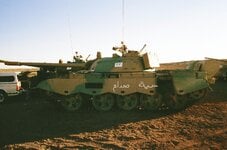 00230054.JPG1,014.5 KB · Views: 45
00230054.JPG1,014.5 KB · Views: 45 -
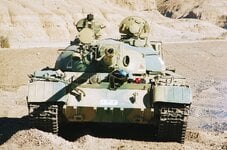 00230050.JPG1.3 MB · Views: 50
00230050.JPG1.3 MB · Views: 50 -
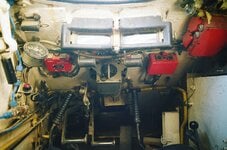 00230049.JPG1 MB · Views: 42
00230049.JPG1 MB · Views: 42 -
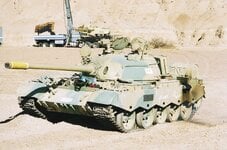 00230048.JPG1.2 MB · Views: 40
00230048.JPG1.2 MB · Views: 40 -
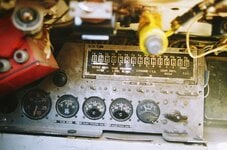 00230045.JPG1.1 MB · Views: 52
00230045.JPG1.1 MB · Views: 52 -
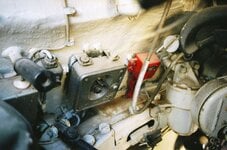 00230038.JPG1.1 MB · Views: 43
00230038.JPG1.1 MB · Views: 43 -
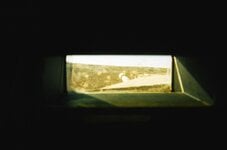 00230036.JPG355.3 KB · Views: 42
00230036.JPG355.3 KB · Views: 42 -
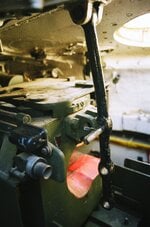 00230035.JPG980.7 KB · Views: 42
00230035.JPG980.7 KB · Views: 42 -
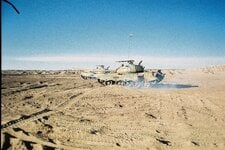 146738-R1-18-1A.JPG2.2 MB · Views: 41
146738-R1-18-1A.JPG2.2 MB · Views: 41
Elvis
1st Sergeant
Anyone know what the idea was behind the sawtooth shape for the skirt over the bogies on the T-55?
Does it make it stealth or sumthin'?

Does it make it stealth or sumthin'?
GrauGeist
Generalfeldmarschall zur Luftschiff Abteilung
The T-55 typically did not have skirts.
It would be interesting to know the back story for that mod.
It would be interesting to know the back story for that mod.
The T-55 was originally a follow on design from the T-34 / 44 with probably elements of the JS series as well.
None of the older tanks had skirts so the 55 didn't either until the AM model was introduced. Visibly this model had better
armour and better turret protection. Skirts were also added due to experience with newer hand held infantry weapons.

T-55

T-55am with extra glacis armour - better turret protection, and skirts.
None of the older tanks had skirts so the 55 didn't either until the AM model was introduced. Visibly this model had better
armour and better turret protection. Skirts were also added due to experience with newer hand held infantry weapons.
T-55
T-55am with extra glacis armour - better turret protection, and skirts.
The T-55 (a modification of the T-54) has almost nothing to do with the T-34. It originated from the T-44, which was completely new in relation to the T-34 - new layout, new armor scheme, new transmission, new undercarriage. Only the engine was a descendant of the V-2 - almost the only thing the T-34 and T-44 had in common.The T-55 was originally a follow on design from the T-34 / 44 with probably elements of the JS series as well.
That's why it's a follow on.The T-55 (a modification of the T-54) has almost nothing to do with the T-34. It originated from the T-44, which was completely new in relation to the T-34 - new layout, new armor scheme, new transmission, new undercarriage. Only the engine was a descendant of the V-2 - almost the only thing the T-34 and T-44 had in common.
Users who are viewing this thread
Total: 1 (members: 0, guests: 1)

